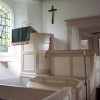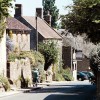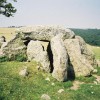In rural communities, more so than in towns and cities, the parish is the twine that binds the people together. Parishes, villages and hamlets have a reason for being and a history deserving to be heard, not least by the people who hold temporal ownership. The name Mappowder is derived from the Anglo Saxon word mapuldor, which means maple tree. As Mapledre this place is recorded in the Domesday Book, giving authority to the suggestion that a settlement existed here well before 1086.
Mappowder has been dismissed as being no more than a few cottages and a nice church, when actually the parish comprises almost 2,000 acres and historically was a part of the Royal Forest. Mappowder Court stands on the site of the original hunting lodge and has been home to several wealthy and important families. A more modest house in the village served as a retirement home and retreat for a famous author and, yes, it does have an interesting church.
As the crow flies Mappowder is about 10 miles north of the county town, directly west of Blandford Forum, south west of Sturminster Newton and south east of Sherborne on the edge of the Blackmore Vale, a beautiful area of the county that Hardy refers to in his novel ‘Tess of the D’Ubervilles’ as “the Vale of Little Dairies.”
A tributary of the River Lydden flows north and west in the southern parts of the parish and another branch of the Lydden forms the north east boundary. According to Isaac Taylor’s 1765 map of Dorset the land south of Mappowder Court and around Thurnwood farm is the 15th century manor and hamlet of Thurnet. Land surrounding Old Boywood farm was, in the 14th century, the manor and hamlet of Hull. The village lies in the south of the parish.
In the 16th century the Coker family set-up home here and built Mappowder Court, which was by all accounts a grand mansion: they reputedly made their fortune from the slave trade. The entrance pillars to their estate topped with sculptured Negro heads proclaiming and celebrating the importance of the family and their involvement with this dreadful trade. The Coker’s left the parish in 1610 and sold the house and estate in 1745. Some members of the family remained in Mappowder between 1610 and 1745; this is evidenced by memorials in the church and cursory glance through the parish register will also confirm this.
It was The Hon. John Spencer who acquired Mappowder Court from the Coker’s. His descendants became the Earls Spencer and one of their daughters, before her untimely death, was the mother of a future King. The Spencer family demolished the grand mansion and replaced it with a smaller house. Later the Wingfield-Digby family purchased the property and held it until the outbreak of the First World War; it has been sold and bought several times since.
On a suitably wet and dismal afternoon I stood outside the entrance to Mappowder Court, it was easy to imagine the Coker family in their mansion with their friends making small-talk over dinner with little thought given to the business being conducted at Bristol in their name or the misery experienced by countless souls to pay for their high living. Today those mounted heads still stand and serve to remind us of a dark period in our history. We might wonder that this business could have been conducted from the seclusion of the Dorset countryside.
John Hutchins tells us a school was built near the church in 1846. It consisted of a single room with large windows and was entered through a porch. The 1851 census records that the schoolmistress had charge of 33 scholars – a ratio we are still trying to improve on a century and a half later.
There were several farmers and dairymen employing 57 agricultural labourers including three women. At this time Sherborne had a thriving button industry and much of the work was out-sourced to home workers in the neighbouring parishes. 37 women and one 1 man in Mappowder worked as buttoners. Of the 290 people living in the parish then, only 182 were born there and the parish overseers had 8 paupers to provide for.
Looking forward forty years we see in 1891 a drop in the population to 195 and it appears the button industry has collapsed. There are still several farmers and dairymen, but employing only 32 men. In the parish are 37 children of school-age and the schoolmistress now has a monitor. The Glove industry employs 13 home workers; there were three laundresses, two carpenters, a mason, a baker and a photographer in the parish.
In 1940 the novelist and unconventional religious thinker Theodore Francis Powys retreated here from the coastal parish of Chaldon Herring where he had lived since 1904. It is said he spent many hours in meditation in the church but was rarely seen at Sunday services. He died in 1953 and he is buried in the churchyard.
The parish church is dedicated to St Peter and St Paul and is a good example of 15th century architecture. The walls are built with squared and coursed rubble with ashlar dressings of Greensand and local limestone. The roof, presently in need of repair judging by the large tarpaulin draped over a part of it when I visited, is covered with tiles and stone-slates. The Nave, South Aisle, West Tower and South Porch date from the late 15th century but some restoration work was carried out during the 19th century, probably in 1868 when the 15th century chancel arch was rebuilt. There is a squint from the South Aisle that opens in the south west corner of the Chancel. Light, even on the dreary day I visited, streams into the church through clear glass there being a noticeable lack of stained-glass.
There is a tiny effigy of a 13th century knight said to commemorate the death of a crusader whose heart was brought back to his parish for burial and carved on a capital near the lectern is a symbol of a Green Man with foliage sprouting from his nostrils. The screen under the tower described by Pevsner as looking Victorian and “prettily flamboyant” was by the Rev. G.A. Coleman and his friend Mr Ringrose and is c.1925.
A 12th century font, some 12th century head-corbels and a reset 14th century window indicate as earlier church stood here.
The West Tower has two stages topped by a plain parapet. The four pinnacles are modern restorations and at each corner a grotesque gargoyle in the form of two monsters and two musicians can be seen. In the upper stage each side of the tower has a belfry window. Until 1999 the belfry housed five bells by W. Knight dated 1735. An anonymous donation of £50,000 was received in time for the millennium to refurbish the bells, which were re-tuned, and a further bell was ordered from The Whitechapel Foundry. The church of St Peter and St Paul at Mappowder now has a peal to rival the best in Dorset.



